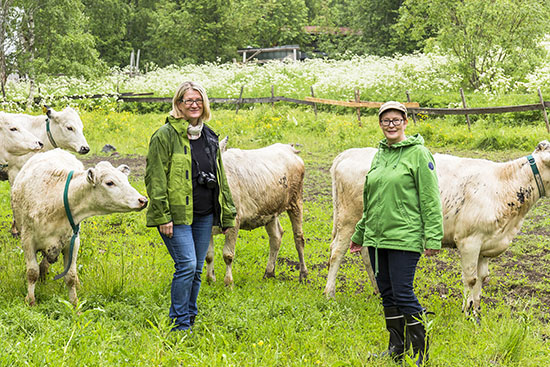Northern Finncattle is an endangered heritage breed. Päivi Soppela and Anne Tuomivaara want to make its delicious, nutrient-packed milk available to discerning gourmets and help revive rural life in Lapland.
Lapparikoulu is an educational project to get Lapland cattle’s milk to the market. In the Arctic Centre at the University of Lapland, with funding from the European Agricultural Fund for Rural Development, project manager, Dr. Päivi Soppela and project coordinator Anne Tuomivaara help farmers and food producers find new ways to use Northern Finncattle milk.
This project is linked with research on the Lapland cattle at the Arctic Centre, where the Lapland cattle’s adaptation to northern conditions, raising and cultural heritage are being studied.
With time, the Lapland cattle have adapted to life in the North – the breed’s qualities are compatible with the circumstances. They thrive with the sometimes-meagre nutrition that the northern nature provides. According to farmers who have Northern Finncattle, they can use almost anything edible they find in nature.
The Lapland cattle are also able to withstand cold weather.
“In the old times, cows were in sheds where the only heating was produced by the animals themselves. If Northern Finncattle individuals remain outside late in the autumn, their hair becomes thicker and furrier than in the summer”, project manager, senior scientist Päivi Soppela describes.
Unfortunately, these fine animals produce less milk than many breeds specifically bred for high milk production. For this reason, the breeds that are better suited to the requirements of intensive farming have gradually replaced Northern Finncattle.
There are also two other vulnerable Finncattle breeds. However, only the northern breed is endangered.
The quality of the Lapland cattle milk is exceptional. For example, it has a higher fat and omega-3 fatty acid proportion than the milk of commercial breeds. The milk properties have been studied to some extent but there is a need for further study concerning e.g. the processing properties.
“It seems that because the dominant breeds have been used in intense farming, their milk is losing the characteristics that Northern Finncattle milk has retained – a higher casein content helps the milk to coagulate more easily than the milk of commercial breeds.”
For cheesemaking the high casein content means getting more cheese with less milk. Some tasty treats have already appeared, but you cannot yet find them in shops, as the cheesemakers sell them directly to individual buyers.
“Oven cheese made of Lapland cattle’s milk is a traditional delicacy. There are plenty of opportunities also for exclusive cheeses and other artisan products. In our project, we want to develop knowhow for producing and branding and get more products to the market”, Päivi Soppela notes.
“Milk producers know that Northern Finncattle milk is top quality. We set up this project to help them refine the milk locally. Product development and brand development could compensate for the smaller volumes; the agricultural producers could earn more with a smaller yield”, project coordinator Anne Tuomivaara explains.
Other aims of the Lapparikoulu project include improving self-sufficiency and food safety in Lapland. To manage this, it is important to maintain diversity within the species.
“It would be a pity if the Northern Finncattle were to disappear, because their genetic makeup is unique. Food self-sufficiency requires animals that could survive even if there was not much feed available from abroad. A more modest breed may one day prove invaluable”, Anne Tuomivaara emphasizes.
The 10th Circumpolar Agriculture Conference opens in Rovaniemi on Wednesday 13 March to share best practices, innovations and perspectives of local agriculture, food production and rural development in the northern areas. One of the sessions deals with Northern native breeds of domesticated animal species.
Photos: Marko Junttila

Top of the page: Lapland cattle individuals are intelligent, curious and approachable.
End of the page: Päivi Soppela and Anne Tuomivaara want to encourage farmers to keep Lapland cattle.